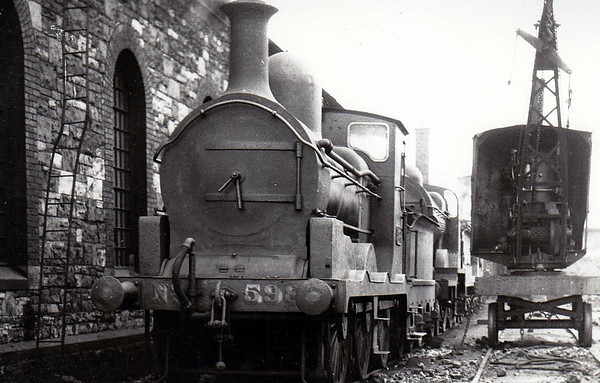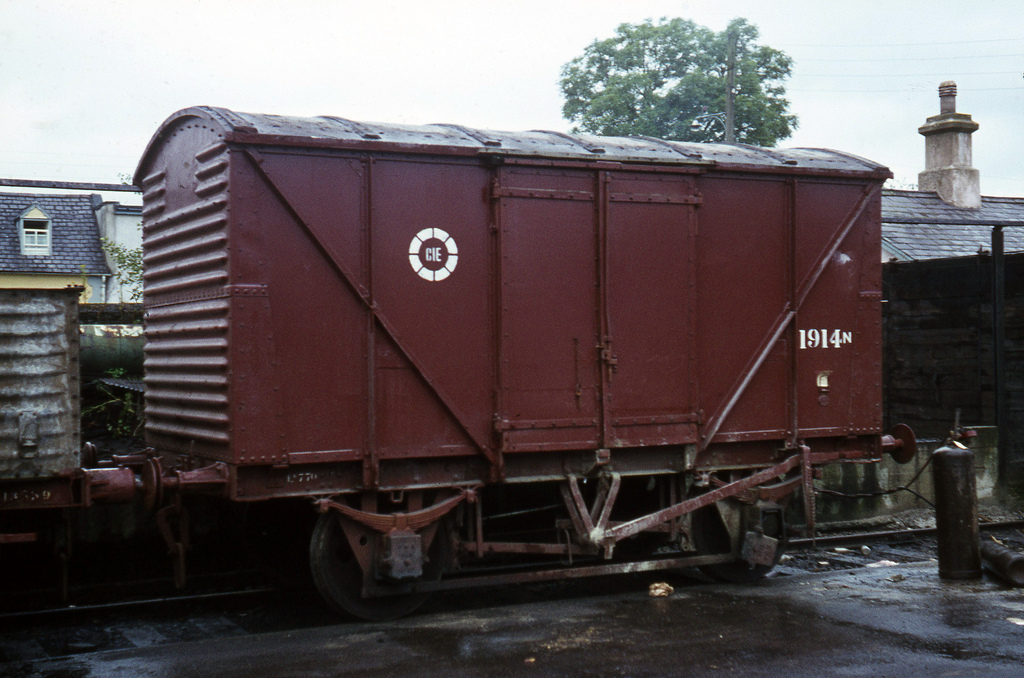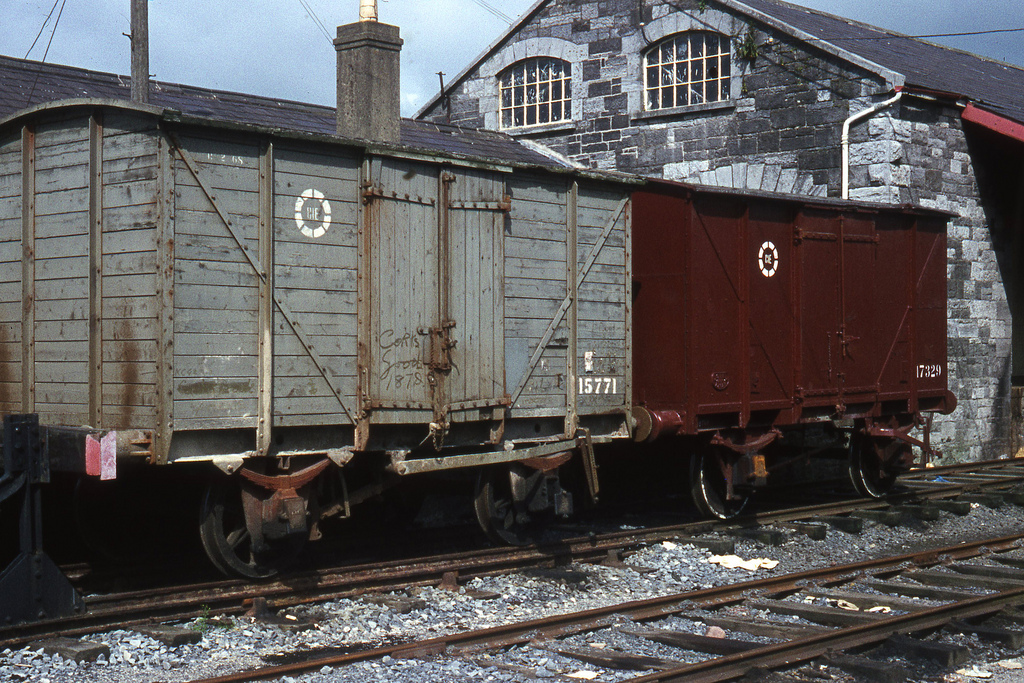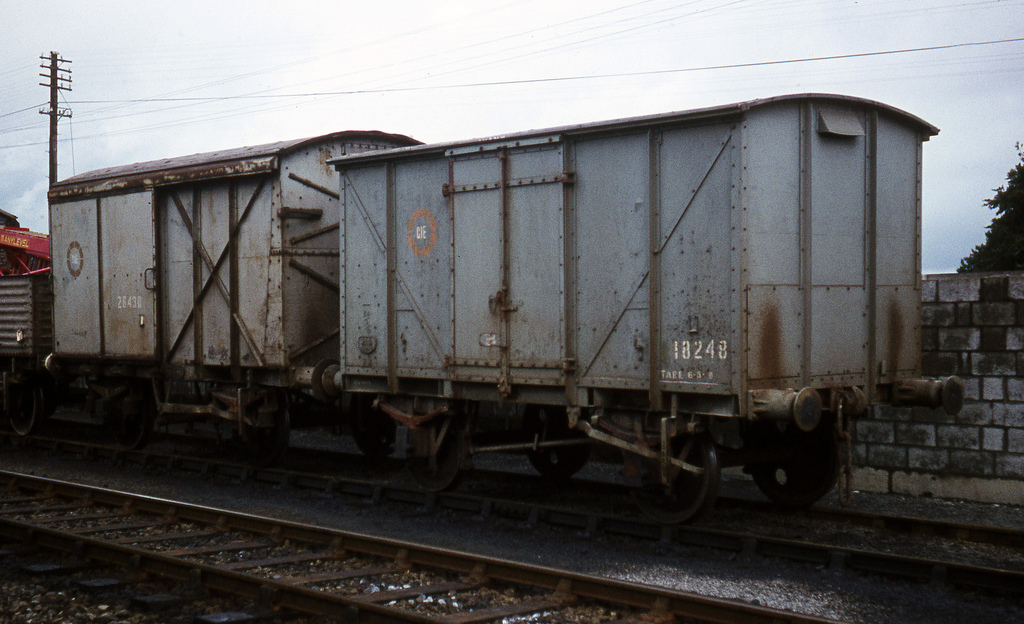-
Posts
4,746 -
Joined
-
Last visited
-
Days Won
119
Content Type
Profiles
Forums
Resource Library
Events
Gallery
Blogs
Store
Community Map
Posts posted by Mayner
-
-
Its probably best to contact Bachmann Europe directly with enquiries for spare parts.
Parts for American locos and stock can be ordered from Bachmann USA on line, but some vital parts for current models are "sold out" with no re-stocking date
-
In my opinion 3d printing has two main issues currently for modellers, 0.1mm resolution is just too rough for compound curves on OO gauge, and self learning an appropriate 3d package that can integrate into the printer.
Nevertheless even with current resolution limits, it has huge potential for renditions that can then be fine touched.
In this part of the World 3D printing is used quite widely both by the trade and individual modellers. There has been something of a shift from using prints from high resolution local printers to make patterns for brass and resin castings to bureaus like Shapeways.
Shapeways WSF material can be remarkably effective for models in S scale and larger.
WSF does not have the layering effect of some of the other materials, the secret in achieving a decent surface finish is to build up the surface in preparation for painting with a primer/filler aerosol, the WSF surface finish is reasonably good as it is for wagons.
Some kit manufacturers are now using Shapeways to produce brass castings produced from 3D models rather than the traditional lost wax or whitemetal casting processes
The better designers tend to be experienced modellers who are also professional CAD draftsmen/ 3D modellers.
-
Agree. For me DCC is being able to operate locos independently on the same section of track without the need for block switching and wiring.
It's just easier to control a loco from a hand held cab rather than a bank of switches and a controller. Sound and lights are a nice bonus, but I don't ever see myself running accessories or points using DCC. In that case the convenience and tactile feel of lever arm switches is more useable than typing silly accessory and point numbers into a cab unit. DCC's momentum capability is nice also, but I have that on my DC inertia controllers anyway (i.e. brake simulation). Having only moved to DCC last august, I'm glad I made the move despite the cost of decoders and the time to retro fit them into old stock. Some were easy to do, but a few were really awkward. The plug in 21pin chips on MM and Bachmann locos couldn't be easier. Split frame Bachmann steam locos are really a no-no for DCC, IMHO.
I have used DCC in N, HO & G Scale American layouts but have stuck with analogue for my Irish narrow gauge layout.
The reason for sticking with DC was the amount of work involved in fitting decoders to small steam locos and unreliable operation as DCC fitted locos tended to be more sensitive to power pick up issues than DC.
I use hand-held rather than panel mounted controllers as I prefer walk-around operation on an end-to end layout. I use live frog points and use the auxiliary switches on "Blue Point" switch machines to route power to the frogs and switch sections between controllers than a separate control panel.
Power pick up was less of an issue with HO & N diesels than small steam locos as the diesels had pick up on both bogies and flywheel drive, while the steam locos picked up on only 4 or 6 wheels.
Northman:
That Morley Vortrak controller seems to be an excellent piece of kit, still use a 40 year old H&M Safety Minor. The combination of panel and hand held control seems to offer the best of both world, hand held for shunting the yard and panel control for watching trains go bye on the main line.
Most of the American style DCC systems are designed for walk-around operation on large American layouts.
At an operating session visiting operators sometimes bring their personal Digitrax or NCE throttle and loco consist to run a particular train. Train movements are often controlled by dispatchers or train controllers from a control panel similar to Connolly signalling centre. Once a detection and signalling system is added there is little to choose between DC and DCC in the complexity and amount of wiring.
CTC Panel Oakland Pacific layout Auckland
-
Hi Andy
There seems to enough interest to go ahead with both the overlays for the Dapol coaches and a scale length/width coach.
I am planning to release side overlays for the Second Open, Brake Second Open and BGSV in September/October. The coach likely to be sometime in 2016 once I have released the MGWR 2-4-0 & CIE 4w container wagons.
Luckily its the middle of winter here and I have more time to catch up on my work backlog
There seems to be a reasonable level of interest in a set of parts for a scale width/length coach
-
The 62'9" wagons were air braked originally used on liner trains to from Dublin to Cork, Limerick and Galway. The wagons were converted to carry timber when the log traffic started in the mid-1990s.
The Galway train was a Liner/Mail with a mixed consist of coaching and freight stock, with the wagon running at the rear of the train behind the mail & parcel vans.
A short train of these wagons appears near the end of Colm O'Callaghans video
-
I wonder would Mallow-Waterford have survived
had the Ballinacourty project had come online
sooner.Mallow -Waterford closed in March 1967,
While the spur to Ballinacourty to service the
Quigley plant came about around 1970.
Trains could have run to Mallow via
Dungarvan, and perhaps beet trains
could have run via Dungarvan as well.
At one stage the GSWR & F&RHR had plans for a cut-off line between Dunkettle & Fermoy to reduce the overall journey time to Rosslare and the possibility of adding Fermoy to the Cork suburban network.
Pfitzer appear to have originally planned a much larger operation at Ballinacourty with quarries at both Bennettsbridge & Lombardstown on the Kerry road supplying dolomite. This would probably resulted in heavier magnesite & oil traffic between Ballinacourty & Cork which would have kept the western end of the line very at least until the 2nd oil crisis hit.
-
Electro-motive seems to have lost serious market share to General Electric and other manufacturers in recent years. Partially to do with the thirsty 2 stroke engine and difficulty in developing a prime mover that meets American & European emission requirements.
Locally Kiwirail are replacing General Motors 645 powered locos with MTU powered Chinese imports but planning to retain GE U Boats for their fuel economy and superior low speed haulage ability on heavy freights on steeply graded twisty lines.
About 10 years ago IE were considering replacing the 201s on MK4 passenger services with "light weight power cars" something that would have made more sense than re-powering the 201s & 071s as most of the high speed milage is on fast passenger rather than freight traffic.
Mullingar-Athlone would need major investment even to be maintained as a diversionary route. The line is disconnected at the Athlone end, most of the sleepers needed replacement and rails were burred over about 20 years ago.
-
Photo of a MGWR 0-6-0 and coaling crane at Broadstone in GSR days.

Possible conversion for the HO Jordan steam navvy? http://www.gclaser.com/ho-scale-jordan-303-erie-b-2-steam-shovel-detail-kit/
-
When I had a proper job, we had a licence-building arrangement in Macon, Georgia, for just that reason - they wouldn't buy the stuff unless they could pretend it was what they like to call "native". We had endless trouble with the stuff they assembled and once, in a meeting about it with my extremely humourless boss, he declared that "These Americans - they're just a bunch of cowboys!" Everybody started laughing and he just couldn't see why. So I said, "Actually, John, some of them are Indians", and he thought I was being racist about immigrants from the Indian sub-continent. It was like working in a mental hospital.
Its nearly 60 years since Eiesenhower warned about the defence industry taking over. The United States foot dragging over the Pacific Trade Agreement is an excellent example of how their approach to trade and protecting American corporates has not really changed much since the 19th Century
-
it may be something to do with enthusiasts being reluctant to get to dirty and close to the coal stage.
Some of the larger depots such as Broadstone, Cork & Tralee seem to have used small self propelled rail mounted steam cranes or even a diesel crawler crane like a 10RB for coaling.
In some depots coal was dumped on the ground and loaded with a crane than using a coal stage, the MGWR used hopper wagons for loco coal traffic between the North Wall and Broadstone. At Broadstone and Cork loco coal wagons were unload from a raised gantry system similar to NER coal drops.
The cranes seem to have used a roll-over skip rather than a grab, so the coal men would have to load the coal into the skip using a shovel, but at crane could tip the coal into the tenders of the larger locos built from the1900s onwards.
I think Anthony Burges book "Chasing the Flying Snail" may have some photos of the coaling arrangements at Tralee
-
[ATTACH=CONFIG]19243[/ATTACH]
Wonderful modelling challenge fits in with the GUBBU years perfectly

-
The vans certainly look the part!
I hadn't thought of swapping the ends between a Parksde Vanfit and a Pallet van to build a pair of Irish Van
-
Has anyone a photo which shows the roof detail for the boiler/generator compartment?
The CIE drawing isn't very clear there appears to be a removable access panel immediately above the boiler and funnel shaped exhaust vent above the generator.
-
My mother was working in England during the War years and had vivid memories from arriving in a blacked-out Midlands up to the invasion
She worked in a Leiceter factory that made radio equipment under the cover of textile manufacture in an attempt to deceive the enemy.
The strategy succeeded in that the factory and Leicester escaped the level of bombing and destruction in nearly Coventry.
They had moralle boosting talks from visitors like Montgomery & Bradley about the importance of their work to the War effort
About mid-morning on 6th June all workers were summoned to a staff-meeting and informed of the invasion.
Her boyfriend an American airborne infantry officer was wounded during the invasion, & put down his survival to my mothers gift of a miraculous medal.
They went their separate ways after the war, but kept in touch and met again more than 40 years later before they both passed away
-
"Sundeala" is a trade name for softboard or woodfibre insulation board it may be sold under a different trade name in Ireland.
I used it on top of chipboard or mdf on open and solid top baseboards in N gauge, and it worked very well with Peco flexible track, could push in the Peco track pins with a small pliers and resulted in extremely quiet reliable running.
For framing I have used everything from traditional 2X1" softwood to braced ply. Ply is probably one of the better options as softwood tends to be more expensive and the poorer grades tend to warp and twist.
-
I've looked up a couple of figures around business travel, and it appears to equate to somewhere between 10% and 20% of all air travel. So, 80%-90% tagging along for the trip? I think not. http://www.businesstravelnews.com/More-News/HRG---Indisputable--Business-Class-Decline-Among-U-K--Companies/?ida=Airlines&a=proc & http://www.quora.com/What-percentage-of-airline-revenue-is-made-from-business-and-first-class-tickets. They pay more for premium seats of course but it's still a small percentage of their business and turnover.
Business travellers coming to Dublin will no doubt have expense accounts, I know I do. Companies will pay for taxi fares to anywhere in the city. If regular people are travelling from Dublin then the LUAS and bus make the journey handy enough, or a taxi if needs be similar to the airport (but not as out of the way for most Dubliners).
Cars make sense in Ireland, but smaller ones make sense in urban areas and they're making less and less sense in Dublin to the point where they're becoming anti-social. I can see a congestion charge situation coming in here in the next few years similar to London, where I thought it was excellent when I lived there as it kept traffic out of central London and easier for everyone to commute.
The UK is seeing a growth in passenger numbers as their public policy is pushing more people to use public transport and the car is not a viable proposition to commute to work. See London congestion charge. The growth is around big city commuter travel as cars offer high costs in parking (and trying to find it) or congestion charge. Any growth rurally is due to heavily subsidized fares from the UK government which to my mind defeats the purpose of a private railway. After all, the privately run railway in Britain cost much more to run than BR ever did.
I think it's unfair to say IE is run to prevent mass unemployment of their employees. Surely their wages and their infrastructure costs much more than any social welfare payments!!!
Not sure if Business Class in Ireland and the UK is more a hangover from the old British class system than anything else, I work for a government body and use air travel regularly in connection with my work, New Zealand Government policy even for senior management is to book the cheapest available flight and use economy class.
The main benefit of Business Class for domestic air travel is the ability to access the Business lounge at major airports rather than the inflight service.
We are finally starting to catch up with Ireland and the UK after some 10-15 years starting to use teleconferencing for meetings and training sessions rather than spending a large part of our budget on travel and accommodation.
Public transport is not really a viable option for business travellers getting to and from an airport or railway station, larger organisations have accounts and agreed rates with taxi companies rather than using individual expense accounts.
Comparison with conditions in the UK is difficult, I don’t think Ireland has the critical mass in terms of population density (overcrowding?), distance and heavy industry to support a main line railway system without a disproptortionately higher level of public subsidy for every passenger carried or tonne/km carried in comparison to countries like the UK. In recent years IE has gone from one of the lowest to highest levels of subsidy per passenger km.
While CIE/IE managed to consistently grow intercity passenger traffic at a single digit rate through the 70-90s, the intercity railway became less relevant in the big scheme of things as despite massive investment and booming passenger figures up to the GFC rail continued to lose market share to the private car.
Surface travel is not a serious option to air in countries with a low population density spread out over a large area. I once used the Overlander to get home on a Saturday from a course in Wellington, unfortunately the most interesting 200 km of the journey was by road as a freight de-railed and blocked the line during the early hours of Saturday morning.
The survival of IE/CIE and the Irish Railway system seems to be a throwback to the protectionist era of the 1930-60 when existing businesses and jobs had to be protected regardless of the cost in terms of damage to the economy and emigration. This mindset supported a resistance to change at both governance and shop floor level that lead to a focus on industrial relations problems as the railways become less and less relevant.
-
CIEs best few years were the 80s and 90s good passenger and freight services and a seemingly modern look on things.
I think the idea of CIE/IE ever having a golden age is something of a contradiction.
While the railways in the 80s & 90s were interesting from a railfans point of view, the reality was a rail system that was approaching a state of collapse with poor services with extended journey times due to inadequate investment, poor staff morale, deferred track and infrastructure maintenance.
The system appears to be in a lot better shape than it was in the 80s & 90s whether the Government should continue to subsidise rail is a difficult political question.
Personally I think 1st Class rail travel is something of a red-herring; the 06:15Cork-Dublin is unlikely to be overcrowded with plebs, more seriously as an employer I would be asking serious questions why I am paying an employees to spend most of the day travelling rather than using video or tele conferencing for an important meeting.
-
I put my money where my mouth was and bought a Park Royal suburban - I think it's a nice job and runs well (behind steam, to boot!). Puzzled by the wheels which seem small - anyone know if they had small wheels? I plan to get a couple more, though quite what excuse I'll use for having it in Portadown ......
The Park Royals, Laminates and Cravens had 3' dia wheel smaller than the 3'7" fitted to British Rail MK1 and most earlier Irish stock.
For some reason Murphy Models used a small 10.45 mm wheel rather than the correct 12mm on the Cravens, I am not sure how this effects coupler/buffer height when coupled to other manufacturers coaches.
-
Splurged out on an 071 & a pair of Cravens for my Matariki (Maori New Year) present.
The prices were very competitive and the Irish VAT refund nicely covered shipping, costs.
Might have to go back to Mark's for some 11pin decoders and other items.
Well done
-
The New Irish Irish Lines archive http://newirishlines.org/ is a good place to search for drawings and photos of CIE wagons Vol 3 May & Nov 2002 has drawings of the standard covered van and Bulleid triangulated underframe by David Malone who published a number of pioneering articles on modelling Irish Railways to Scalefour standards in the 80s & 90s including Practical Model Railways and Model Railway Digest
-
The plastic tank arrangement is a home-brewed automatic flange lubricator - the track has numerous tight bends and the squeal could get rather annoying.
The apparatus is zeroed at the start of each trip and it then counts the axle revolutions during each trip. Water is then automatically sprayed on the bend sections. It actually seems to work quite well in terms of reducing the squeal.
The GSWR 2-4-2T locos designed for the Valentia & Kenmare branches were originally fitted with a water spray arrangement to reduce rail/wheel wear on the sharp curves.
The RNAD wagons take me back to my volunteering days on the Welsh Highland Heritage Railway in Wales in the 90s. The vans were an ending of the Cold War dividend to various mainly 2' gauge preservation schemes up and down the UK. The wagons were used at Royal Navy ammunition depots in various parts of the UK and sold by public auction/tender. Most of the vans had the imprint of shells in the floor.
Being the Navy the wagons were generally in good condition the only problem the wagons were to 2'6" gauge. The re-gauge involved pumping the wheels out on the axle using a large hydraulic press, machining a shoulder on the axle and pressing the wheels back to the correct back to back on the press.
-
The GNR 16t bagged cement vans were very close in design the BR standard ply sided 12t van and the Parkside kit. Approx 140 of these vans were assembled by the GNRB in the 1950s all of which went to CIE following the break up of the GNR in 1958
The main difference from the BR vans was the brake gear and the absence of ventilators in the ends. The Irish vans only had handbrakes with independent either side hand brakes similar to oil tank wagons and mineral wagons rather than the Morton clutch and vacuum brake arrangement on standard BR wagons and vans.
GNR bagged cement van
The CIE standard H van was developed from a GSWR design and quite different in outline and design of underframe to the BR vans.
Bodywork the H vans mainly plywood sides and ends, different strapping detail and a flatter roof profile than the BR vans. Underframe Inchacore pattern buffers, either a standard Irish Railway Clearing House underframe or Bulleid triangulated underframe with hand brakes with one brake shoe per side, the fitted version had an 8 shoe clasp brake arrangement, the handbrake operated by a handwheel rather than lever.
GSWR & CIE standard H van
26000 series pallet vans.
Similar in design to the earlier BR Palvan but with pressed metal ends and sliding doors, unfitted on Bulleid Triangulated underframes.
These wagons appear to have been assembled using components imported from the UK. The body is quite different in detail to the excellent Parkside kit, the CIE vans had at least 3 different designs of end stamping.
H van and Pallet van
Some people have used the Parkside BR van as a basis for building/kitbashng the Irish vans but involves a lot of work.
-
For a moment I thought you were starting a layout based on the Phoenix Park Tunnel line with a station near the real North Circular Road serving the Stoneybatter area of Dublin

I travelled quite a bit over the North London and other London Cross country lines, even reaching Dalston Junction after it was closed to regular passenger services.
Tons off atmosphere short passenger trains and unusual motive power on Interegional freight trains.
Will the layout have a 3rd or 4th rail?
I preferred the old ex Southern Region slam door to the more modern 303 units, then there was the oddity of BR EMUs mixing with Tube stock between Queens Park and Harrow & Wealdstone on the Euston-Watford DC line.
-
[ATTACH=CONFIG]19034[/ATTACH]
Like the joke about the lid not fitting on a famous (notorious) UK kit manufacturers coffin http://www.rmweb.co.uk/forum/viewtopic.php?f=11&t=14708
.png.c363cdf5c3fb7955cd92a55eb6dbbae0.png)

.jpg.0c2c0c73649a1556581201ead0109773.jpg)




South Wexford Line
in What's happening on the network?
Posted
IEs agreement with the NTA for 'mothballing' involves a programme of inspection and maintenance to ensure the Barrow Viaduct does not become a hazard to shipping, managing the liability risk for IE (securely fenced, bridges and level crossings not a hazard to the users) and weed killing to keep the line clear for ail traffic until the track became unsafe for rail traffic.
The agreement does not appear include sleeper or level crossing barrier replacement and IEs proposal discussed using tie bars to maintain the gauge until sleeper decay became a significant problem.
I suppose the message is to get out there and record any train or inspection movements over the line while there is still a chance, whats happening on the South Wexford is not radically different to Mullingar-Athlone in the early 1990s by 1996 the line was unfit for rail traffic.